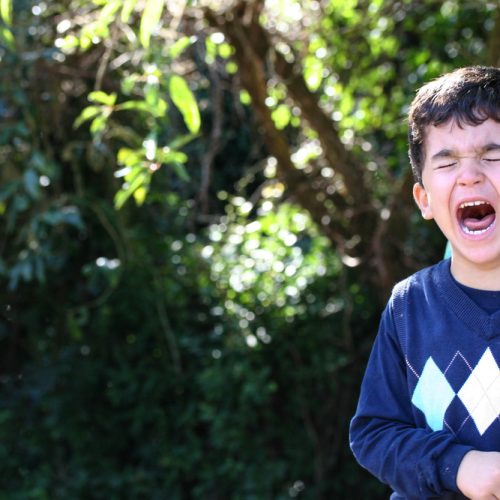The main takeaways for this guide take two minutes to read. It contains information from seven sources, including the Child Mind Institute and the American Academy of Pediatrics. See the full list below.
It is hard to define “normal,” especially when it comes to kids behavior, because it is often determined by the context of the situation. But there is consensus among experts on how to spot drama or emotional outbursts that are (or aren’t normal for an early school age child (5-7).
Here are our biggest takeaways after reviewing research and interviews with seven expert sources:
- The most common way we saw experts defining abnormal behavior was by measuring how frequently extreme outbursts are happening (more than 3 times per week), over how long (more than a few months), and in what location (beyond just the home).
- Tantrums can still happen at this age but are typically a lot less frequent and intense than they are from toddlers. And emotional outbursts of course still happen – kids are human!
- Emotional outbursts that seem out of proportion to the situation and are repetitive can be a sign of what experts call “emotional dysregulation.” The tantrums or tears are not malicious, they are a maladapted or immature way of dealing with feelings.
- Given that, most experts recommended trying to identify patterns around what time of day or people or other elements might be triggering an outburst. That can then help you figure out how to address them.
- They also emphasized viewing kids managing emotions as a skill to be taught versus bad behavior.
- If you are dealing with what you think are abnormally intense emotional outbursts, reach out to your pediatrician. There are therapeutic programs, like dialectical behavioral therapy, that they can refer you to.
Jump to:
- What Is Normal Behavior for a 5, 6, or 7 Year Old?
- …And What’s Not Normal For Early School Age Children
- How To Help Your Kid Learn to Deal With Their Emotions (Without a Tantrum or Tears)
Want a quick way of seeing developmental milestones for ages 5 through 7?
Drop your email and we’ll send you a FREE, mobile-friendly graphic that breaks down the developmental milestones for ages 5 through 7, including reading, tying their shoes, and counting to 100. Favorite it so you can access whenever!
What Is Normal Behavior for a 5, 6, or 7 Year Old?
Everyone has emotional outbursts from time to time, even adults. We’re human! Many sources emphasized that early school age children (5-7) are still learning how to regulate their emotions. And just like other developmental milestones, exactly when that happens can differ from child to child.
The American Academy of Pediatrics had a good description of what is normal or not when it comes to a child’s behavior:
“A fine line often divides normal from abnormal behavior, in part because what is ‘normal’ depends upon the child’s level of development, which can vary greatly among children of the same age. Development can be uneven, too, with a child’s social development lagging behind his intellectual growth, or vice versa. In addition, ‘normal’ behavior is in part determined by the context in which it occurs – that is, by the particular situation and time, as well as by the child’s own particular family values and expectations, and cultural and social background.”
Despite the variation from one kid to another, it is understandable that parents want to determine whether their child’s crying, tantrums, or anger is normal.
Meghan Leahy, a parenting coach with a column in the Washington Post, had a succinct way of describing what to really pay attention to. She wrote that it is the “frequency, duration and intensity” of the outbursts that can signal how serious a problem is.
The Child Mind Institute has a similar take: if a school age child is frequently having meltdowns and outbursts, “it may be a sign that they have difficulty with emotional self-regulation.”
But overall, experts emphasized that you should still expect your kids at this age to be learning how to deal with their emotions. (And I’m sure we know plenty of adults who seem to have never learned!) As two psychologists at Children’s National hospital put it: “Young children have fewer ways of identifying and coping with their emotions so these types of behaviors are not uncommon at this age.”

…And What’s Not Normal For Early School Age Children
The Child Mind Institute has an excellent overview of when emotional outbursts, especially anger, veer into not being normal.
Here are the top things they note:
- Outbursts frequently happening beyond developmentally normal age (up to 7 or 8)
- Being a danger to themselves or others
- Causing trouble at school
- Unable to get along with other kids
- Outbursts are disrupting family life
- They feel out of control or bad about themselves due to outbursts
The Child Mind Institute says children experiencing “frequent, extreme tantrums” who are “irritable most of the time” may have disruptive mood dysregulation disorder (DMDD). Dr. Stephanie Samar, a psychologist at the institute, says kids are often brought in around 8 to 10 years of age, and “they’ve been having trouble with these symptoms for a while and may have tried therapy in the past.”
And here is how the DSM, the guidebook psychologists use to diagnose disorders, outlines the following criteria for DMDD:
- Temper outbursts that are severe and recurrent (more than three times per week) and are out of proportion with the situation and child’s developmental level
- Mood between outbursts is persistently irritable and angry, nearly every day and it is observable by others
- Symptoms are present for more than 12 months in two out of three settings: home, school or with peers
- Over 6 years old, start of behavior under 10 years old
How To Help Your Kid Learn to Deal With Their Emotions (Without a Tantrum or Tears)
Even if your child is totally normal, there are ways to help them learn how to react to their emotions appropriately.
Scott Bezsylko, the executive director of a school for children with learning disorders, had a good way of describing how parents should think about outbursts: as a skill to be learned, not a behavior to be punished.
“We approach self-regulation skills in the same way we approach other skills, academic or social: isolate that skill and provide practice,” Bezsylko told the Child Mind Institute. “When you think of it as a skill to be taught — rather than, say, just bad behavior — it changes the tone and content of the feedback you give kids.”
Here are some of the most common ways experts recommend helping your child process emotions:
— Try to spot trends in when the bad behavior is happening. Is it at certain times of day? After certain requests? Around specific people? Knowing that can “help figure out strategies for prevention,” according to psychologists Leandra Godoy and Amanda Hastings.
The Child Mind Institute also flagged common times or events that can upset children:
- When they don’t understand expectations (they caution this can happen even if you think they understand)
- Transition from one activity or place to another, especially without warning
- Giving a long series of instructions or asking rapid-fire questions
If you notice outbursts happening in those times, CMI outlines specific ways here to approach those situations.
— Be their emotion coach. Psychologists from Children’s National write that parents can view themselves as an “emotion coach” and help their child “learn how to identify, express and cope” with feelings…when they are calm and not in the middle of an outburst. Have a conversation with your child and ask them what feelings or emotions they made have had at that moment, in as nonjudgmental way as possible.
— Put your attention on positive behavior. Several sources recommend trying to ignore negative behaviors (when feasible) and giving more attention to positive behaviors. So if your child can calmly ask for a snack instead of screaming for one, be specific and tell them good job for using their polite voice.
— Make your child the center of a story. Known as “social stories,” these aim to help kids understand the behavior you want to see. You write the story with your child and make them the main character. In the story they will do the positive behavior you are looking to get, so for example, they will brush their teeth and put on their pajamas when it’s bedtime, instead of crying and running away.
Sources:
- 3-Year-Old Behavior Problems & What Is Normal | Child Mind Institute
- American Academy of Pediatrics: Normal Child Behavior
- DMDD | Kids With Extreme Tantrums and Irritability | Child Mind Institute
- DSM-5: Disruptive Mood Dysregulation Disorder (nih.gov)
- How Can We Help Kids With Emotional Self-Regulation? (childmind.org)
- Is My Child’s Anger Normal? | Anger Management for Kids (childmind.org)
- My almost 5-year-old is acting out. Help! | Children’s National (childrensnational.org)
- Parents Guide to Problem Behavior | Child Mind Institute
- Waldorf Early Childhood: The Six Year Old
- Warning Signs of Normal and Abnormal Child Behavior (verywellfamily.com)
- What can we do about a 6-year-old who throws violent tantrums? (childmind.org)


